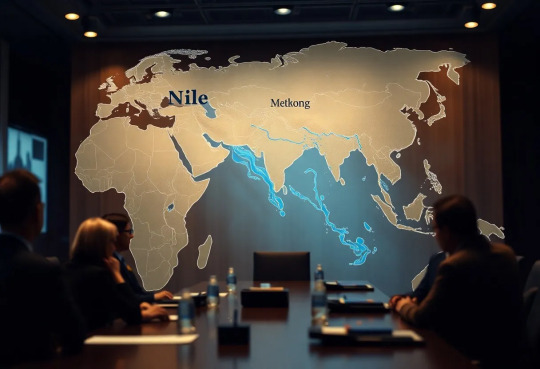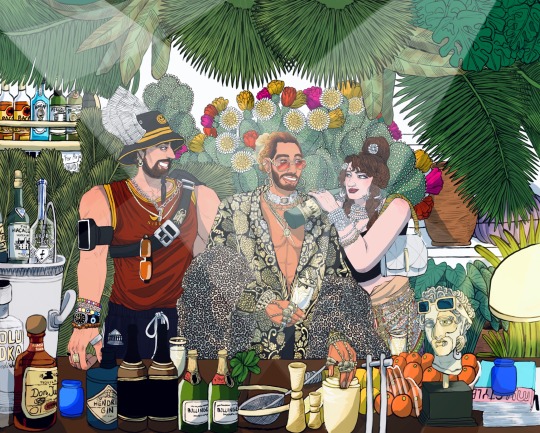#transboundary
Explore tagged Tumblr posts
Text
Water Wars – Nile, Mekong, and Indus in Future Negotiations
Conflicts over water resources are escalating in the Nile, Mekong, and Indus river basins, driving nations to the brink of serious confrontations. He knows the implications are massive as governments scramble for control over these vital sources, making the stakes extremely high. They need to be aware of how inequitable access and environmental impacts could spark tensions, but they also have an opportunity to forge collaborative agreements that could lead to sustainable solutions. She encourages them to engage in dialogue and innovative strategies before these water wars turn into dire consequences.

Table of Contents
The Geopolitical Landscape of Water Scarcity
Navigating Legal Frameworks: Treaties and Agreements
The Role of Environmental Changes
Power Dynamics: Influence of Regional Stakeholders
Practical Strategies for Effective Collaboration
Summing up
The Geopolitical Landscape of Water Scarcity
Historical Context of Water Allocation
Water, often referred to as the essence of life, has long been a contentious resource among nations sharing river basins. The Nile River, one of the world’s longest rivers, has seen countless treaties and agreements forged since the British colonial era, starting with the 1929 Nile Waters Agreement. This agreement granted Egypt substantial control over the river’s waters, effectively sidelining upstream countries like Sudan and Ethiopia. Historical missteps continue to echo in modern diplomatic discussions, as Egypt clings to its long-held privileges while upstream nations seek equitable rights and exploitations for their burgeoning populations and economies.
The Mekong River, flowing through six countries, presents a similarly tangled web of historical usage. The Mekong Agreement of 1995 attempted to foster cooperation among nations, but age-old grievances remain, with countries like Laos pursuing hydropower projects to energize their economies at the expense of downstream nations such as Vietnam and Cambodia. Cambodian fishermen and farmers feel these shifts, struggling as water flow and seasonal patterns shift, showcasing how historical allocations have lasting implications on livelihoods.
Current Tensions in River Basin Management
Today, the stakes couldn’t be higher. For example, Ethiopia’s Grand Renaissance Dam has stirred anxieties in Egypt, which fears that reduced water flow could spell disaster for its agricultural backbone. A staggering 90% of Egypt’s water supply comes from the Nile, making any disruption a matter of survival. As negotiations unfold, they highlight the deep divisions between historical rights and modern needs, raising questions about justice in water sharing. Ethiopia argues that it must capitalize on its resources to develop, while Egypt sees its future as potentially jeopardized.
In the Mekong Basin, tensions have also ramped up as countries grapple with dam construction and declining fish stocks. Vietnam’s Mekong Delta, increasingly vulnerable to saltwater intrusion and sediment loss, faces dire economic implications if upstream developments continue unchecked. This complex relationship among the nations extends beyond immediate resource usage, as they wrestle with the implications of climate change, population growth, and persistent inequality in water distribution.
As he examines the ongoing hostilities, he notes that the intricate dynamics of these river basins illustrate how water scarcity magnifies existing tensions. They reveal a deeper metaphorical layer, where water allocation is not merely about resources, but also about power, identity, and the very essence of survival. The continuing dialogue around the Nile, Mekong, and Indus rivers embodies a broader geopolitical struggle over natural resources in an era defined by increasing scarcity and competition. Each decision taken by upstream and downstream nations reverberates beyond borders, prompting the urgent need for cooperative frameworks that genuinely acknowledge every party’s needs and rights.
Navigating Legal Frameworks: Treaties and Agreements
Key Treaties and Their Impact on Negotiations
Heavily influencing the dynamics of international water negotiations, several key treaties exist around the Nile, Mekong, and Indus rivers. The 1959 Nile Waters Agreement, for example, ostensibly allocated rights to Egypt and Sudan for the development and utilization of Nile waters, but it did not consider upstream nations like Ethiopia, which has led to contentious disputes in recent years—especially with Ethiopia’s Grand Renaissance Dam project. Likewise, the Mekong Agreement of 1995 established a framework for cooperative development that nearly all Mekong Basin countries agreed upon, but non-compliance from certain nations complicates collaborative governance. Meanwhile, the Indus Waters Treaty, signed in 1960 between India and Pakistan, provided a transformative structure for managing water flows, yet the persistent tensions over territorial issues continuously threaten to undermine its effectiveness.
Challenges in Enforcement and Compliance
Despite the establishment of treaties, enforcement and compliance remain major hurdles. He noted that many agreements lack robust mechanisms to enforce compliance or address violations effectively, often leaving countries to act unilaterally based on their water needs. Without significant penalties or incentives for adherence, nations may prioritize immediate economic interests over long-term collaborative strategies. For instance, in the Indus region, rising water demands have driven India to pursue aggressive dam projects, raising concerns in Pakistan about water security, yet no formal mechanisms compel or incentivize responsible water usage among riparian states.
Read More : Water Wars — Nile, Mekong, and Indus in Future Negotiations
#water wars#nile river#mekong river#indus river#transboundary water disputes#water security#future negotiations#geopolitical tensions#hydropolitics#international rivers#climate change and water#water sharing agreements#global south#freshwater conflict#regional cooperation
0 notes
Text
Thailand and Cambodia Sign Landmark MoU on Transboundary Environmental Pollution
Bangkok/Phnom Penh, April 25, 2025 – In a historic step to strengthen regional environmental cooperation, Thailand’s Minister of National Resources and Environment and Cambodia’s Minister of Environment signed a Memorandum of Understanding (MoU) on Transboundary Environmental Pollution today. The signing took place during the official visit of Thailand’s Prime Minister to Cambodia, marking the…
#Cambodia#Diplomatic Relations#hazardous waste#Mekong River#MoU#Thailand#transboundary environmental pollution#waste management#water pollution
0 notes
Text
Turbulent Waters: Unraveling the India-China Struggle Over the Brahmaputra
The waters of the Brahmaputra, or Yarlung Tsangpo as it is known in Tibet, have always been a lifeline for millions. Yet, they are now becoming a flashpoint in the geopolitical tensions between India and China. With Beijing’s ambitious plans to construct a colossal $137 billion hydropower project in Medog County, the stakes for South Asia’s environmental and water security have reached unprecedented heights.
China’s proposed dam, designed to harness the staggering 2,000-meter drop of the Brahmaputra’s flow, promises to generate 60,000 MW of power—enough to light up entire nations. However, for India and Bangladesh, this “green project” risks becoming a poisoned chalice. The environmental consequences and geopolitical implications could ripple far downstream, impacting millions who depend on the river for their livelihoods...Read more
#India-China relations#Brahmaputra River#Yarlung Tsangpo#hydropower project#South Asia water security#Tibet ecosystem#environmental risks#Himalayan dams#transboundary river cooperation#India-China geopolitics
0 notes
Text
#air quality index#delhi air pollution#Lahore pollution#Pakistan#Bangladesh#transboundary issue#news#delhi pollution level schools closed#delhi pollution worsens#Air Quality Management
0 notes
Text
Nepal’s Industrialists Challenge Energy Policies Amid Discussions of Transboundary Energy Transition
Industrialists in Nepal have expressed their concern over the implementation of demand-side management (DSM) by the Nepal Electricity Authority (NEA). The DSM measures, which impose load shedding on industries, have spurred discontent within the Nepal Industrial Enterprises Association. During a recent meeting, industry representatives articulated their grievances, claiming that while they are…

View On WordPress
#Bangladesh#DSM#fossil fuels#green energy investment#Hydropower Projects#India#Nepal#Nepal Electricity Authority (NEA)#transboundary energy transition#Upper Karnali hydropower project
0 notes
Text
Taliban's Chitral River Dam: Unraveling Regional Water Security and Relations in South and Central Asia
Taliban's Chitral River Dam: Unraveling Regional Water Security and Relations in South and Central Asia #TalibanDam #WaterSecurity #Geopolitics #ChitralRiver #KunarRiver #Diplomacy #RegionalRelations #SouthAsia #CentralAsia #IndusWatersTreaty #Taliban
The very essence of South Asia and Central Asia’s water security pivots on the lifeblood provided by transboundary rivers such as the Indus, the Ganges, the Brahmaputra, and the Amu Darya. These vital arteries sustain the lives, livelihoods, and ecological equilibrium of millions across Afghanistan, Pakistan, India, China, Nepal, Bangladesh, Tajikistan, Uzbekistan, Turkmenistan, and Kazakhstan.…

View On WordPress
#Afghanistan#Chitral River#Diplomacy#Energy Security#Geopolitics#Hydroengineering#India#Indus Waters Treaty#Kunar River#Pakistan#Regional Cooperation#Regional Relations#Regional Stability#Taliban#Transboundary Rivers#Water Security
0 notes
Link
0 notes
Text
Experienced genuine intellectual interest in and excitement about something for the first time in a long time and it was a Cambridge PhD student describing her thesis, which is eight case studies of transboundary peoples, those who live, e.g., at the northern/southern Irish border, or the US/Mexico border, and cross it back and forth regularly for everyday life activities: school, work, shopping, visiting friends and family, etc. Most importantly, she analyzes how this is a right not enshrined in international law but enacted as though it is. I got excited because this is precisely how the border between Poland and the Ukrainian USSR functioned in Volhynia during the 1920s (and even into the 1930s), before the institution of international law--in that case, it was the continuity of pre-WWI boundaries in practice, on which authorities were instructed to crack down, but which they largely ignored or permitted with bribes. The porousness of borders, the way local communities interact with them, and the way empire vs. nation-state vs. other formations interact with each other vis-a-vis borders and the communities that live around them--those are my FAVORITE topics. I hope her thesis is public domain!!!!!
#I hope I can READ#dispatches from the academy#autodidact tag#I need a tag to organize my studies I guess
38 notes
·
View notes
Text
An Alaska-based coalition of Indigenous governments has applied to be part of a B.C. environmental review process. Representatives of the Southeast Alaska Indigenous Transboundary Commission say they're concerned about the environmental impacts of a proposed project that would see work resume at Eskay Creek, a former open-pit gold mine. The mine, which mining company Skeena Resources hopes to revive, lies about 85 kilometres northwest of Stewart, B.C. Skeena's proposal would see workers make use of some of the old mine's existing facilities, extracting up to three million tonnes of gold and silver ore per year. The proposed mine would be in operation for nine years. If the Alaska coalition is successful, it would be the first time in history that U.S.-based tribes are granted the ability to participate this way in Canada.
Continue Reading
Tagging @politicsofcanada
#cdnpoli#canada#canadian politics#canadian news#british columbia#alaska#indigenous#first nations#environmental justice
65 notes
·
View notes
Text
First World Day for Glaciers was celebrated on 21 March 2025
The 2025 global campaign for the World Day for Glaciers and World Water Day, will highlight the various impacts of glacier changes on downstream communities and ecosystems, and the urgent need for developing water-related adaptation strategies in areas affected by shrinking or disappearing glaciers, more transboundary cooperation and community engagement, alongside continued support for ambitious reductions in fossil fuel consumption.
11 notes
·
View notes
Text










Glacier National Park, MT (No. 3)
The park has numerous ecosystems, ranging from prairie to tundra. The easternmost forests of western redcedar and hemlock grow in the southwest portion of the park. Forest fires are annually common in the park. There has been a fire every year of the park's existence except for in 1964. In total, 64 fires occurred in 1936 alone, the most on-record. In 2003, six fires burned approximately 136,000 acres (550 km2), more than 13% of the park.
Glacier National Park borders Waterton Lakes National Park in Canada—the two parks are known as the Waterton-Glacier International Peace Park and were designated as the world's first International Peace Park in 1932. Both parks were designated by the United Nations as Biosphere Reserves in 1976, and in 1995 as World Heritage Sites. In April 2017, the joint park received a provisional Gold Tier designation as Waterton-Glacier International Dark Sky Park through the International Dark Sky Association, the first transboundary dark sky park.
Source: Wikipedia
#Going to the Sun Road#Glacier National Park#Little Chief Mountain#travel#original photography#vacation#tourist attraction#landmark#landscape#Rocky Mountains#Montana#countryside#USA#summer 2024#Mountain West region#flora#nature#architecture#Wild Goose Island#Saint Mary Lake#Point 8376 of Goat Mountain#Fusillade Mountain#Mahtotpa Mountain#Napi Rock
4 notes
·
View notes
Text

FANDOM : love and deepspace CHARACTER : sylus / qin che OUTFIT : transboundary SIZE : 75x75 NUMBER OF ICONS : 210 EDITS : lightly sharpened NOTES : please give a like or a reblog if you use. edit as you please. DOWNLOAD : dropbox
PREVIEW :

4 notes
·
View notes
Text




Something for my close friend, Arja (@greypetrel of the @thelastbacchae); as her birthday is coming soon, and I hoping that all of these three gods bring us a good year, too. ❤️💕
Dionysus's golden grapevine patterned vest was inspired by the maximalist designs of the Indian fashion designer, Rahul Mishra and his runway exhibition in The Tree Of Life, Couture 2022. And for the surrounding background, I was inspired by modern minimalist industrial club design; mixing with the Mediterranean background that the gods was born and raised in; and some vibrant tropical foliage. (a nod of his travelings to the East) I had to admit that, since Dionysos and Ariadne themselves were too versatile and multifaceted as gods with beautiful contrasts historically; choosing their outfit and their own sense of fashion styles in order to echoing their juxtaposition is very difficult; beside normal club fashion styles. Transhuman, transgender, transnational, transboundary and always in transitory places between the liberating pure chaotic madness and the core of human civilization.
P/S: Also to Arja herself, drawing them makes me miss the times that I often go out and club with friends, tbh.

27 notes
·
View notes
Text
Solar Geoengineering: What is It, Why People Support It, and How to Make It Safer
By the Atlantic States Environmental Coalition
What is Solar Geoengineering?
Have you ever felt hopelessness over global leaders’ failure to stop global warming? There may be a new way to slow global warming that can be implemented easier than you’d expect. Solar Geoengineering (SG) is “solar radiation management which attempts to increase reflection of solar radiation away from the earth in order to slow [global] warming.” The 2 primary types of SG are stratospheric aerosol injection (achieved by releasing reflective particles like sulfate aerosols into the atmosphere) and marine cloud brightening (achieved by “spraying sea water into the lower atmosphere to generate brighter, more reflective clouds”). SG is increasingly mentioned by scientists as a way to combat climate change. SG’s appealing qualities include its low implementation cost, little opposition to it from industries, and the likelihood of it having fast cooling effects on the planet. However, as you might have guessed, SG also comes with significant risks. How and where SG will change climate patterns is unknown, and it could reduce ozone in the atmosphere, which is critical for preventing harmful UV radiation from reaching earth. Additionally, while SG will lower global temperatures, it doesn’t address the root cause of climate change, which is GHG emissions. It won’t reduce other harmful effects of GHGs either, such as air pollution and ocean acidification. But perhaps most scarily, an increased reliance on SG could lead to something called “termination shock.” Termination shock would cause a rapid and extreme rise in global warming if SG were to be deployed, but suddenly terminated, due to failing technologies.

Image by the Union of Concerned Scientists
Why are Some Actors Hoping to Pursue SG as a Climate Change Mitigation Strategy?
Despite its risks, some governments are looking at SG precisely because of its almost immediate impact on temperature reduction and ease of deployment. It’s probable that present mitigation efforts under the Paris Agreement won’t be enough to hinder catastrophic climate change. On October 24, 2024, the United Nations Environmental Programme (UNEP) reported that collectively, countries have made no progress tackling climate change. Their report said:
"As greenhouse gas emissions rose to a new high of 57.1 gigatons of carbon dioxide equivalent in 2023, the cuts required from today are larger; 7.5 per cent must be shaved off emissions every year until 2035 for 1.5°C. Current promises are nowhere near these levels, putting us on track for best-case global warming of 2.6°C this century and necessitating future costly and large-scale removal of carbon dioxide from the atmosphere to bring down the overshoot."

(Likelihood of global warming exceeding the temperature increase limits of the Paris Agreement. Source: UNEP Emission Gap Report 2024)
SG is not mentioned among the possible solutions that could reverse this dire trend by UNEP in the report. However, several actors are considering it anyway. In the U.S., the company Make Sunsets has already begun deployment of balloons that release sulfur dioxide into the atmosphere. President Biden also released an executive order directing all agencies to research SG, calling it “One of the most promising [climate change mitigation] strategies.” Despite SG having garnered opposition from the international community, it’s looking increasingly likely that some countries will use it in the near future.
What Needs to be Done to Make Solar Geoengineering as Safe as Possible?
Given the likelihood of the planet warming above what global leaders hoped for, they may need to further explore SG, but not without limitations on how it’s used. There needs to be comprehensive national guidelines on SG to prevent it from causing transboundary harm. Both NASA and the EPA in their proposed rulemakings responding to the executive order stated that they intend to create grant programs for SG research and use the data gathered to shape their future SG policies. Data collection on SG is a good start. Additionally, the agencies responding to President Biden’s executive order on SG should ensure that SG will not be subsidized at the expense of safer GHG mitigation efforts. Both NASA and the EPA should use their grant programs to place contingencies on SG research that will make actors do an equivalent amount of GHG mitigation. It doesn’t matter whether the agencies provide the money for an equivalent amount of GHG mitigation, or require applicants use their own funds. Agencies just need to ensure that SG is a supplementary rather than alternative method to combat climate change. Then agencies will reduce impacts of climate change other than temperature rise, and the severity of termination shock from possible SG cessation. If you agree with ASEC’s suggestions, please comment your support on NASA and the EPA’s proposed rulemakings at www.regulations.gov.
Thank you,
ASEC
#note: this post is a class assignment that we had to post publically#asec is a fictional organization#biden's executive order on SG and the agencies' proposed rulemakings are also fictional#do feel free to further research SG and submit comments to the agencies telling them to regulate it though#solar geoengineering#climate change
6 notes
·
View notes
Text
Tides of Change Addressing Global Garbage on Alaska's Beaches

Alaska's pristine coastline, often celebrated for its rugged beauty and untamed wilderness, faces a growing threat: an influx of garbage from around the globe. Despite its remote location, Alaska's beaches are not immune to the pervasive problem of marine debris, with trash washing ashore from distant shores. From plastic bottles to fishing gear, this garbage poses a significant environmental hazard, endangering wildlife and spoiling the natural beauty of these coastal landscapes.
While Alaska's beaches may seem isolated, they serve as a final destination for marine debris carried by ocean currents from far-flung regions. Discarded items from coastal communities, commercial fishing vessels, and even overseas shipping contribute to the mounting problem of garbage washing up on Alaska's shores. Once ashore, this debris can persist for years, polluting habitats, entangling marine life, and leaching harmful chemicals into the environment.
The impact of marine debris on Alaska's coastal ecosystems is profound. Wildlife, including seabirds, marine mammals, and fish, often mistake plastic fragments for food, leading to ingestion and starvation. Entanglement in discarded fishing nets and lines can prove fatal for marine animals, hindering their ability to feed, swim, and reproduce. Moreover, the accumulation of garbage diminishes the aesthetic value of Alaska's beaches, tarnishing their allure for residents and visitors alike.
Addressing the issue of global garbage on Alaska's beaches requires a concerted effort at local, national, and international levels. Coastal communities must implement waste management strategies to reduce the amount of trash entering marine environments, including recycling programs, beach cleanups, and public education campaigns. Collaboration between government agencies, non-profit organizations, and industry stakeholders is essential to coordinate cleanup efforts and promote sustainable practices.
Furthermore, international cooperation is vital to address the root causes of marine debris, including plastic pollution and improper waste disposal. Multilateral agreements, such as the Basel Convention and the International Maritime Organization's MARPOL Annex V, aim to regulate the transboundary movement of hazardous waste and prevent marine pollution. By strengthening these agreements and enforcing regulations, the global community can mitigate the impacts of marine debris on Alaska's beaches and beyond.
In conclusion, Alaska's beaches are not immune to the scourge of marine debris, with garbage from around the world washing ashore on its pristine shores. The proliferation of plastic pollution, discarded fishing gear, and other waste poses a significant threat to coastal ecosystems and wildlife. Addressing this issue requires collective action at the local, national, and international levels, including waste management initiatives, cleanup efforts, and international cooperation. Only through concerted efforts can we protect Alaska's beaches and preserve their natural beauty for future generations to enjoy.
2 notes
·
View notes
